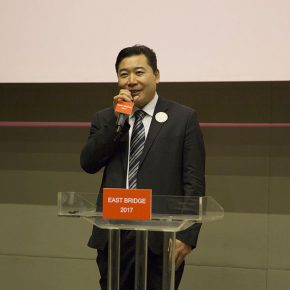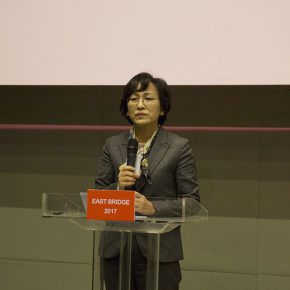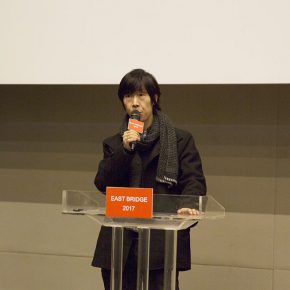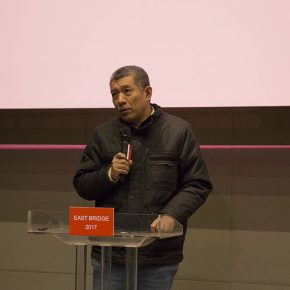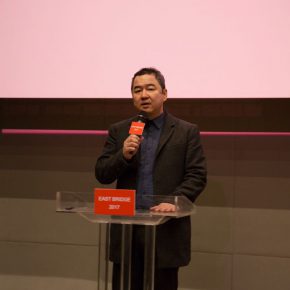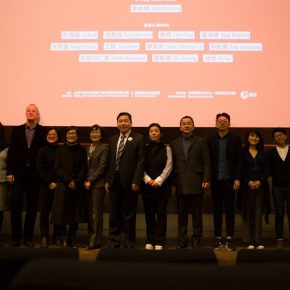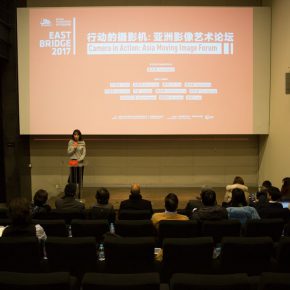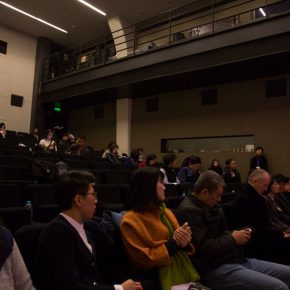
At 10:30 on November 25, 2017, the 4th East Bridge “Camera in Action: Asia Moving Image Forum” was held at the Ullens Center for Contemporary Art. Wang Yanling, President of Seven-Star Group and the Beijing 798 Creative Industry Investment Co., Ltd., Park Hyang-Joo, Minister of Culture and Art of the Korea Foundation, Dr. Clemens Treter, Institutsleiter of Goethe-Institute China, Dong Bingfeng, a researcher of the SIMA of China Academy of Art, Chinese artist Xu Tan, and Prof. Yoo Jinsang from Kaywon University of Art & Design, Korea, attended the press conference.
East Bridge is a cross-border art exchange project based on artistic integration and interaction, since its launch in 2014, the East Bridge project has been successfully held over the past three years. It was co-organized by the Beijing 798 Creative Industry Investment Co., Ltd. and the Korea Foundation, in the form of one forum for each year. After several months of preparation, it invited 11 scholars, artists, curators and representatives of the art institutes from China, Korea, Japan, Singapore, Hong Kong and Taiwan, attempting to through different perspectives of artists from different countries & regions to promote & establish an academic exchange & common research platform of the “moving image” in Asia, bridging the art of East Asia in order to have a better dialogue with the international art scene.
At 4:00 pm, the forum was officially held at the Goethe-Institute China. It was a two-day forum divided into three sections. In the forum, scholars combined the topics such as the development of the moving image in Asia, the creation of multimedia & new technologies, localized writing & art activity, the changes in multimedia art in the system of the biennale & art gallery, gathering to explore the current situation & problems of the development of the moving image, as well as the positioning in the global art world, around the performance & themed evolution of the social conditions & artistic context in different regions of East Asia and Southeast Asia. Section one “The Past and Present Perspective of the Asian Image Art” invited Jung Hyun, Associate Professor in Visual Art at INHA University, Korea, Linda Chiu-han Lai, Professor of City University of Hong Kong, Hong Kong, Sing Song-yong, Professor in Graduate Institute of Animation and Film Art of Tainan National University of the Arts, Taiwan, and Fang-Tze Hsu, Independent researcher and curator, Singapore, to respectively deliver a keynote speech on the topics including Korean contemporary media artists, “Moving Image” the theory of sculpture, the self-portrait of post martial law in Taiwan moving image arts, “(De-)Cold War in Asia and the Acoustic Unconscious”.
Section II “Individual Practice and Research” invited Chinese artist Xu Tan and Korean artist Je Baak to deliver a keynote speech. Starting from his own “Keyword Lab” project in 2005, Xu Tan talked about how to transform the social analysis into art? How to transform perception and aesthetic operation into an analytical method? Moving image art was an indispensable channel and media. The technological development triggered both the 4th industrial revolution and the question of “who we are”, starting from which Je Baak said that it was necessary to take a critical attitude in answering this question, and media art was the pioneer, so that his works focused on the connection between media technology and industrial technology. Section III “Archives, Institution Operation and Exhibition Managing Practice” invited Dong Bingfeng, Academic Chair of the forum, Chen Tong, Co-founder of Video Bureau, China, Hitomi Hasegawa, Director of MIACA (Moving Image Archive of Contemporary Art Japan), Yoo Jinsang, Professor in Kaywon University of Art & Design, Korea, and Beck Jee-sook, Artistic director of SeMA Biennale Mediacity Seoul 2016, Korea, to have discussions on the individual cases, archives, and curatorial plans.
Why did the exhibition discuss the topic of Asia, especially focusing on East Asia? Dong Bingfeng believed that different from the EU which was a geographical concept, Asia was involved in an ancient Confucian cultural circle. Contemporary art or moving image was an important cultural medium in the process of modernization in Asia. The forum of the moving image was intended to present a variety of differences, distances and complexities in Asia, and it has proposed a series of theoretical ideas and many possibilities in artistic practice.
At present, there are more and more correlations happening between art and social practice. The moving image has become an important & indispensable channel & medium for artists to move from their artistic world towards real society. In addition to performance art, the majority of artists engaged in social intervention use image as a media and material for the conceptual expression and artistic creation. Rather than a simple tool, the camera with a function of recording is able to accurately express social and cultural issues through the creation of artists. The forum was entitled “Camera in Action” in order to focus on the exploration of critical potential from the production of image (camera) to the social practice (actor) in the Asian scene.
“Moving Image Art” is a rather inclusive topic generally referring to all the artistic forms and research topics of the “Moving Image”. In the Asian region, the historical framework and artistic expression of “moving image” has gone beyond the scope of contemporary art, and it is closely related to social history, cinema and cultural & political conditions in different countries and regions. The inclusiveness of the “moving image art” is embodied in the complexity and transcendence between the industry of image production and the field of art, and also constitutes the most “current” and cutting-edge artistic language and cultural form of contemporary art.
At the conference, Wang Yanling, President of Seven-Star Group, gave a brief review of the history of East Bridge. He pointed out that it held a forum for the moving image of the year, instead of an exhibition, in order to theoretically prepare for the exhibition of moving image in the future. East Bridge would focus on the subdivided market of the moving image in the future, and more deeply explore the connotation of artistic development.
Text and photo by Yang Zhonghui, translated by Chen Peihua and edited by Sue/CAFA ART INFO


